Exotic
Talponia batesi (Heinrich) (Tortricidae: Olethreutinae: Grapholitini)
FWL: 5.0-6.5 mm
Forewings are broadly triangular with a strongly arched costacosta:
the anterior margin of each wing  , a row of black dots along the termentermen:
, a row of black dots along the termentermen:
the outer edge of the forewing  , and a conspicuous notch below the apexapex:
, and a conspicuous notch below the apexapex:
the point furthest removed from the base or at the end of the costal area  . The basal half of the wing is olive green while the apical half is extensively marked with metallic striations. Males lack a forewing costal foldforewing costal fold:
. The basal half of the wing is olive green while the apical half is extensively marked with metallic striations. Males lack a forewing costal foldforewing costal fold:
a flap or fold at the base of the forewing that contains specialized sex scales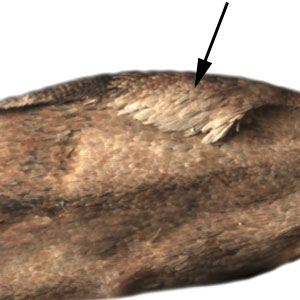 . Hindwings are brown.
. Hindwings are brown.
Male genitalia are characterized by long, extremely thin, apically setosesetose:
covered with setae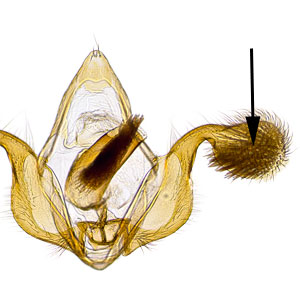 socii; and valvaevalvae:
socii; and valvaevalvae:
plural of "valva" with a well-developed cuculluscucullus:
with a well-developed cuculluscucullus:
the distal portion of the male valva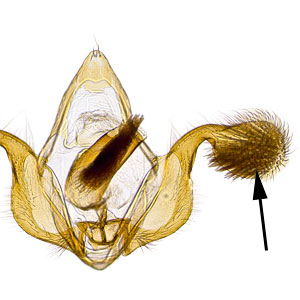 with a strongly constricted neck. Female genitalia are characterized by a basally sclerotizedsclerotized:
with a strongly constricted neck. Female genitalia are characterized by a basally sclerotizedsclerotized:
hardened; usually in reference to larval structures or adult genitalia 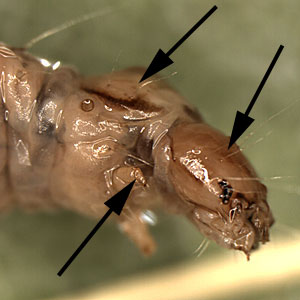 ductus bursaeductus bursae:
ductus bursaeductus bursae:
a membranous tube connecting the ostium bursae to the corpus bursae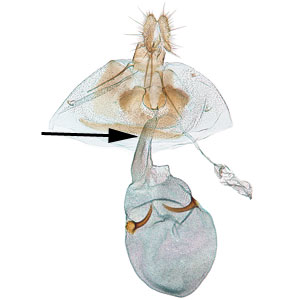 ; two large thorn-like signasigna:
; two large thorn-like signasigna:
plural of "signum" ; and a mesally constricted corpus bursaecorpus bursae:
; and a mesally constricted corpus bursaecorpus bursae:
a dilated membranous sac at the anterior end of the bursa copulatrix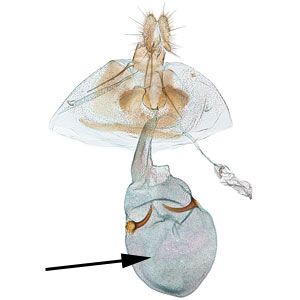 .
.
The following account is summarized from Castañeda-Vildózola et al. (1996).
Last instar larvae are approximately 8-10 mm in length with a whitish abdomen. The head is yellowish brown and the prothoracic shieldprothoracic shield:
a sclerotized plate on the dorsal surface of the prothorax 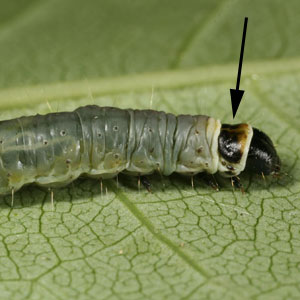 is brown to yellowish brown. No detailed descriptions of larval chaetotaxychaetotaxy:
is brown to yellowish brown. No detailed descriptions of larval chaetotaxychaetotaxy:
the arrangement of setae (in reference to Lepidoptera larvae), often depicted on a "setal map"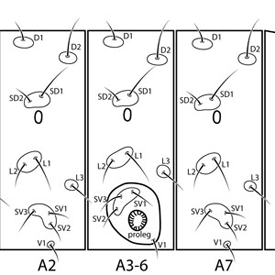 have been published, but according to MacKay (1959)MacKay (1959):
have been published, but according to MacKay (1959)MacKay (1959):
MacKay, M. R. 1959. Larvae of the North American Olethreutidae (Lepidoptera). Canadian Entomologist, Supplement 10: 1-338., the larvae of T. plummeriana are extremely similar (see below).
The only other member of this genus, T. plummeriana, is recorded from the eastern half of the United States where it feeds on Asimina spp. (pawpaw); there are also unverified records of T. plummeriana from Mexico. The two species are similar in appearance but T. plummeriana is easily distinguished from T. batesi by the reddish color on the apical half of the forewing. Genitalia of the two species are quite different and a dissection can be used to confirm identity.
Talponia larvae can be distinguished by the large, single, brown pinaculumpinaculum:
singular of "pinacula"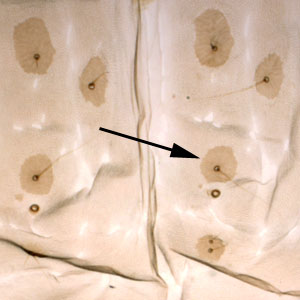 on A9 where the D1, D2, and SD1 setae are located. Other morphological features include: SV setal counts on A1,2,7,8,9 as 2:2:2:2:1 or 2:2:2:1:1; SD1 on A8 anterodorsal to spiracle; abdominal setae short; anal combanal comb:
on A9 where the D1, D2, and SD1 setae are located. Other morphological features include: SV setal counts on A1,2,7,8,9 as 2:2:2:2:1 or 2:2:2:1:1; SD1 on A8 anterodorsal to spiracle; abdominal setae short; anal combanal comb:
a toothed structure on the last abdominal segment used to eject frass away from the feeding larva; also termed "anal fork"  absent.
absent.
The following account is summarized from Castañeda-Vildózola et al. (1996) and Peña et al. (2002).
Females lay eggs on the flowers and fruits of Annona. Larvae bore into the fruit and feed inside until mature. Pupation occurs in leaves outside of the fruit. The number of generations per year is unknown although it is assumed that larval development is synchronized with fruit development.
This species is a serious pest of Annona, and in Mexico crop losses on cherimoya range from 45-100% if larvae are not controlled. Talponia batesi is commonly intercepted at U.S. ports of entry on Annona originating from the Caribbean, Mexico, or Central America.
| Host plant | Host plant family | Reference(s) |
| Annona cherimola | Annonaceae | John's larval key |
| Annona glabra | Annonaceae | Heinrich 1932Heinrich 1932: Heinrich, C. 1932. A new species infesting Annona (Lepidoptera: Olethreutidae). Proceedings of the Entomological Society of Washington. 34: 20-23.; USDA/APHIS interceptionsUSDA/APHIS interceptions: USDA/APHIS interceptions. Based on larvae intercepted by USDA-APHIS personnel at U.S. ports-of-entry and identified by Systematic Entomology Laboratory personnel. |
| Annona muricata | Annonaceae | USNM collectionUSNM collection: USNM collection. Based on identified reared specimens in the collection of the National Museum of Natural History, Washington, D.C. |
| Annona sp. | Annonaceae | MacKay 1959MacKay 1959: MacKay, M. R. 1959. Larvae of the North American Olethreutidae (Lepidoptera). Canadian Entomologist, Supplement 10: 1-338. |
View full screen host table here
Talponia batesi has been recorded from the Caribbean, Mexico, and Central America. Larvae are commonly intercepted at U.S. ports of entry on Annona originating in Guatemala or Mexico.